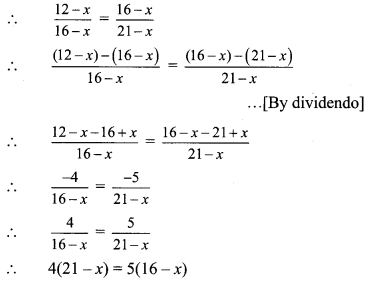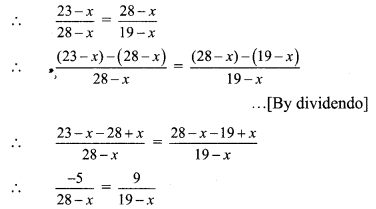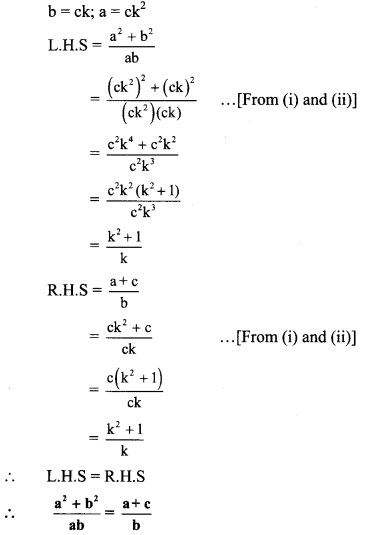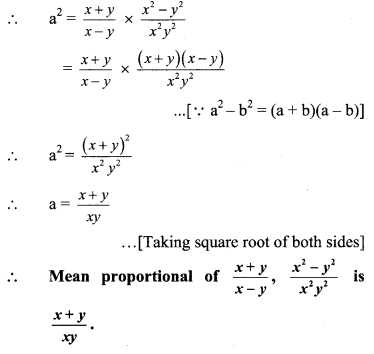Balbharti Maharashtra State Board Class 9 Maths Solutions covers the Practice Set 4.5 Algebra 9th Class Maths Part 1 Answers Solutions Chapter 4 Ratio and Proportion.
9th Standard Maths 1 Practice Set 4.5 Chapter 4 Ratio and Proportion Textbook Answers Maharashtra Board
Class 9 Maths Part 1 Practice Set 4.5 Chapter 4 Ratio and Proportion Questions With Answers Maharashtra Board
Question 1.
Which number should be subtracted from 12, 16 and 21 so that resultant numbers are in continued proportion?
Solution:
Let the number to be subtracted be x.
∴ (12 – x), (16 – x) and (21 – x) are in continued proportion.

∴ 84 – 4x = 80 – 5x
∴ 5x – 4x = 80 – 84
∴ x = -4
∴ -4 should be subtracted from 12,16 and 21 so that the resultant numbers in continued proportion.
Question 2.
If (28 – x) is the mean proportional of (23 – x) and (19 – x), then find the value ofx.
Solution:
(28 – x) is the mean proportional of (23 – x) and (19-x). …[Given]

∴ -5(19 – x) = 9(28 – x)
∴ -95 + 5x = 252 – 9x
∴ 5x + 9x = 252 + 95
∴ 14x = 347
∴ x = \(\frac { 347 }{ 14 }\)
Question 3.
Three numbers are in continued proportion, whose mean proportional is 12 and the sum of the remaining two numbers is 26, then find these numbers.
Solution:
Let the first number be x.
∴ Third number = 26 – x
12 is the mean proportional of x and (26 – x).
∴ \(\frac { x }{ 12 }\) = \(\frac { 12 }{ 26 – x }\)
∴ x(26 – x) = 12 x 12
∴ 26x – x
2
= 144
∴ x
2
– 26x + 144 = 0
∴ x
2
– 18x – 8x + 144 = 0
∴ x(x – 18) – 8(x – 18) = 0
∴ (x – 18) (x – 8) = 0
∴ x = 18 or x = 8
∴ Third number = 26 – x = 26 – 18 = 8 or 26 – x = 26 – 8 = 18
∴ The numbers are 18, 12, 8 or 8, 12, 18.
Question 4.
If (a + b + c)(a – b + c) = a
2
+ b
2
+ c
2
, show that a, b, c are in continued proportion.
Solution:
(a + b + c)(a – b + c) = a
2
+ b
2
+ c
2
…[Given]
∴ a(a – b + c) + b(a – b + c) + c(a – b + c) = a2 + b2 + c2
∴ a
2
– ab + ac + ab – b
2
+ be + ac – be + c
2
= a
2
+ b
2
+ c
2
∴ a
2
+ 2ac – b
2
+ c
2
= a
2
+ b
2
+ c
2
∴ 2ac – b
2
= b
2
∴ 2ac = 2b
2
∴ ac = b
2
∴ b
2
= ac
∴ a, b, c are in continued proportion.
Question 5.
If \(\frac { a }{ b }\) = \(\frac { b }{ c }\) and a, b, c > 0, then show that,
i. (a + b + c)(b – c) = ab – c
2
ii. (a
2
+ b
2
)(b
2
+ c
2
) = (ab + be)
2
iii. \(\frac{a^{2}+b^{2}}{a b}=\frac{a+c}{b}\)
Solution:
Let \(\frac { a }{ b }\) = \(\frac { b }{ c }\) = k
∴ b = ck
∴ a = bk =(ck)k
∴ a = ck
2
…(ii)
i. (a + b + c)(b – c) = ab – c
2
L.H.S = (a + b + c) (b – c)
= [ck
2
+ ck + c] [ck – c] … [From (i) and (ii)]
= c(k
2
+ k + 1) c (k – 1)
= c
2
(k
2
+ k + 1) (k – 1)
R.H.S = ab – c
2
= (ck
2
) (ck) – c
2
… [From (i) and (ii)]
= c
2
k
3
– c
2
= c
2
(k
3
– 1)
= c
2
(k – 1) (k
2
+ k + 1) … [a
3
– b
3
= (a – b) (a
2
+ ab + b
2
]
∴ L.H.S = R.H.S
∴ (a + b + c) (b – c) = ab – c
2
ii. (a
2
+ b
2
)(b
2
+ c
2
) = (ab + bc)
2
b = ck; a = ck
2
L.H.S = (a
2
+ b
2
) (b
2
+ c
2
)
= [(ck
2
) + (ck)
2
] [(ck)
2
+ c
2
] … [From (i) and (ii)]
= [c
2
k
4
+ c
2
k
2
] [c
2
k
2
+ c
2
]
= c
2
k
2
(k
2
+ 1) c
2
(k
2
+ 1)
= c4k
2
(k
2
+ 1)
2
R.H.S = (ab + bc)
2
= [(ck
2
) (ck) + (ck)c]
2
…[From (i) and (ii)]
= [c
2
k
3
+ c
2
k]
2
= [c
2
k (k
2
+ 1)]2 = c
4
(k
2
+ 1)
2
∴ L.H.S = R.H.S
∴ (a
2
+ b
2
) (b
2
+ c
2
) = (ab + bc)
2
iii. \(\frac{a^{2}+b^{2}}{a b}=\frac{a+c}{b}\)

9th Standard Algebra Practice Set 4.5 Question 6. Find mean proportional of \(\frac{x+y}{x-y}, \frac{x^{2}-y^{2}}{x^{2} y^{2}}\).
Solution:
Let a be the mean proportional of \(\frac{x+y}{x-y}\) and \(\frac{x^{2}-y^{2}}{x^{2} y^{2}}\)
